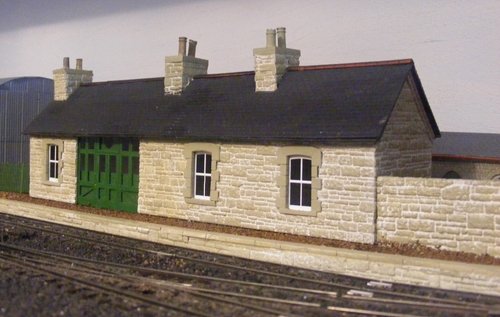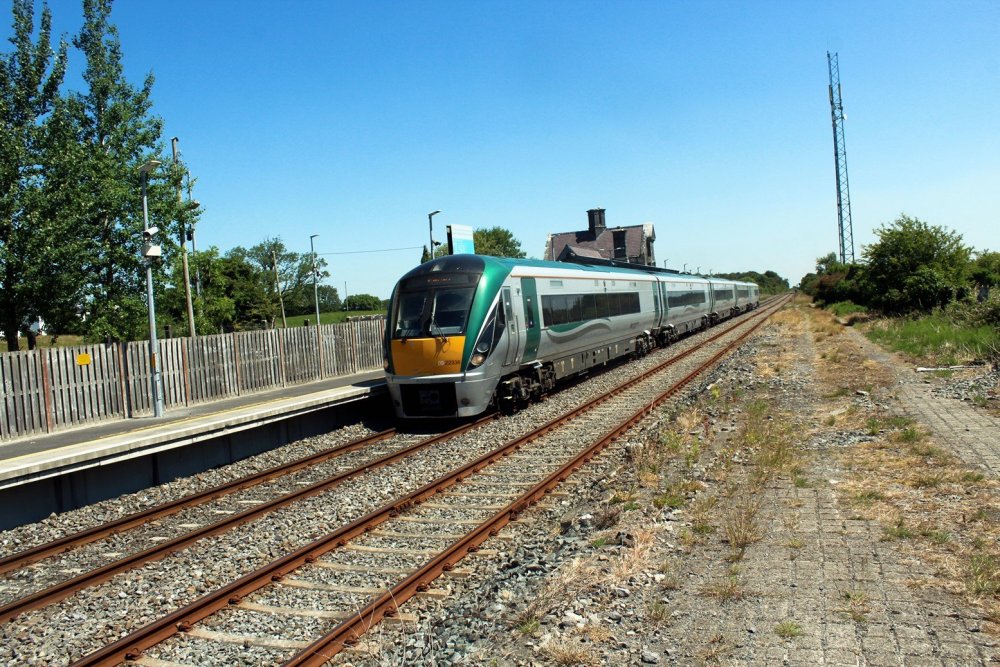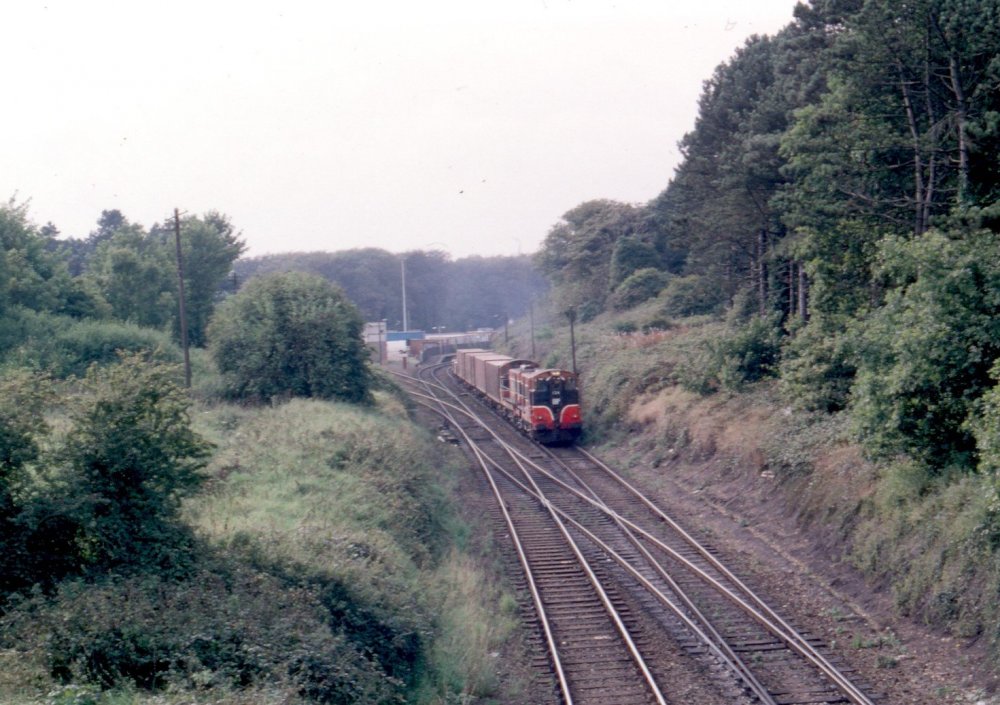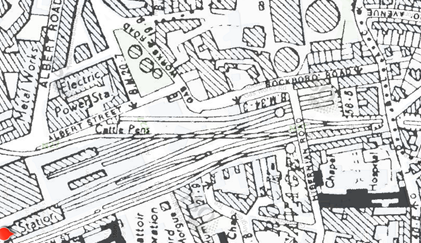-
Posts
4,875 -
Joined
-
Last visited
-
Days Won
119
Content Type
Profiles
Forums
Events
Gallery
Everything posted by Mayner
-
For corrugated asbestos Iain Rices Plastic Structure Kits Making the Most of the Wills Scenic Series. Iain recommended wet brushing with a pale bluff colour then dusting with talc before the paint dries. This probably helps capture the chalky look of a newish asbestos roof before it discolours and darkens with moss and algae growth. I spayed the Wills asbestos sheets on the walls on my corrugated goods shed on my narrow gauge layout with grey auto primer & it seems to look the part.
-
The large wheeled MGWR F/GSR 623/J5 were known as the "Cattle Engines" the first true mixed traffic engine they worked cattle trains from the great fairs on the Midland system, and sometimes Night Mails and excursion traffic. Rebuilt from a large GSWR 0-6-2T banking loco. A Waterford loco apparently nicknamed the "Reverend Mother" with those small wheels she would not run fast no-matter how wide the driver opened the regulator. Jumbo Waterford's Goods Yard and Dock Pilot rebuilt from an 0-6-4 back Tank in 1896. A very popular loco supposed to have been a city institution. MGWR As GSR 545 "Celtic Class" 4-4-0 most powerful MGWR passenger class largest Irish 4-4-0 when introduced in 1902. Ended up on cattle trains bumped from Midland Section main line passenger services with the introduction of the Woolwich moguls, to heavy to be used on South Eastern section. MGWR C/ GSR 536&540 "Connemera" or "Kylemore" Class 4-4-0 Introduced for use on Mayo & Sligo lines 1910 onwards later rebuilt with large superheated boilers. Used mainly on slower Midland Passenger and Cattle trains. Not the most successrful design with a reputation of rough riding and heavy on coal, though seem to have preformed well on Dublin-Limerick via Nenagh trains in the 1930s!
-
The shed looks really impressive Tony, your determination to persevere with Omagh is seems to be paying off.
-

Bachmann Irish Railway Complete Train Set Factory Sealed
Mayner replied to burnthebox's topic in For Sale or Wanted
An item this size is more likely to be detected by customs than a small package sent by Airmail. I sometimes use the E-Bay Global Shipping programme for items from the States this avoids the cost and delay associated with customs clearance. -
I love that LSWR Royal Saloon the Timpleague & Courtmacsharry seems to be the closest thing in Ireland to a Colonel Stephens light railway. I built a pair of standard GSR open wagons in 4mm using similar techniques to your MGWR coal wagons simple and great fun to build, though still have not gotten round to fitting the break gear 20 odd years later.
-
Brian McCann built an N Gauge exhibition layout based on Bagnalstown that was featured in the Railway Modeller during the early 1980s, the layout included reasonably accurate models of the station buildings including loco shed and the branch line was incorporated into the main circuit, the layout also included models of the Waterford line Barrow & Nore Viaducts. Building or kit bashing the train would be challenging in OO would be challenging in the absence of a suitable loco kit or ready to run donor locomotive. If you want to build a reasonably accurate model of the train O gauge might be a better option than OO as the 2-4-2T version of the loco is available as a brass kit from Alphagraphix and GSWR 6 wheel coach kits/parts are available from Alphagraphix and Worsley Works. Alternatively it should be possible to re-create a reasonable copy of the train that passes the 2' rule in OO or even N by kit bashing a British RTR loco into the 0-6-0T version of the GSWR loco with modified or re-painted Trtr 4 wheel coaches. A diorama featuring the Borris viaduct and a train in either OO or N gauge would make an impressive model The loco looks like a 37 Class or C7 4-4-2T introduced by the GSWR in the early 1900s. A brass kit of the 33 Class or F6 a 2-4-2T version of the same loco is available from Alphagraphix in O Gauge. Both classes appear to have been introduced a a light tank locomotive for Cork Suburban and branch line passenger and mixed train service and seem to have been reasonably successful. Many years ago someone kitbashed a passable model of a 201 class out of a Triang Jinty.
-
2954 is just about visible at the right hand end of the coach in the photo. I did not realise that CIE carried out such major conversions of relatively elderly GSWR coaching stock into the 1950s. It almost looks like Inchacore went back to the 1900 TPO design for the conversions, the door,window and paneling arrangement appears to be similar to the earlier TPOs.
-
Freight traffic on the Dublin-Rosslare line during most of the Liner Train era was basically limited to Ammonia and fertiliser traffic in connection with the Shelton Abbey plant and bagged cement specials from Platin to Wexford. A daily Liner train operated carrying container & keg traffic from the late 1970s until discontinued in the early 1980s serving Arklow, Enniscorthy and Wexford. Liner traffic was light (average 6--------4w flat wagons) the train could only carry 10 & 20' containers and keg traffic. In its final years Liner traffic ran attached to the rear of bagged fertilizer trains between North Wall and Shelton Abbey. The loco of the morning fertilizer train from North Wall continuing to Wexford with Liner traffic after dropping the empty fertilizer wagons at the plant and collecting the laden wagons on the return working.
-
"GSWR Carriage Diagrams" by H Richards & B Pender a 1975 Transport Research Associates re-print of the 1924 GSWR Carriage Diagram Book. The late Padraig O'Cuimin published IRRS Journal papers on MGWR wagon and coaching stock in the early 1970s. I understand that hard and digital copies of some drawings are available from the IRRS http://irishrailarchives.ie/index.php/archives/maps_drawings/
-
2 roof lights above the mail sorting section & toilet cistern at one end.
-
The TPOs a bit of a puzzle. The majority of GSWR and MGWR 6w and bogie TPOs had been officially withdrawn from service before the B121 Class entered service. Van appears to be a bogie rather than a 6w van (4 axleboxes showing) with GSWR rather than MGWR design features, including roof profile, gas lighting, window profile and continuous lower foot boards. Looks very close to 245 a 45' GSWR TPO built in 1900 officially withdrawn in 1959 . Van appears to be in good cosmetic condition painted in the late 50s green with single eau-de-nil stripe paint scheme. A pair of GSWR built TPOs survived into the 1960s these were longer more modern looking vehicles with elliptical roofs completely unlike the van in the Athenry photo Its just about possible that GSWR TPO was "cascaded" from the Southern on to the Midland to replace a more modern ex-MGWR TPO as Inchacore rolled out its first batch of Laminate TPOs in 1959.
-
Waterford received bulk cement for either the Drogheda (Platin) or Limerick cement factories. Cahir Viaduct on the Waterford-Limerick line was out of service between Oct 2003 & Sept 2004 as a result of the derailment of a Limerick-Waterford bulk cement train. Its possible that the train in the video was diverted to run via Rosslare Strand as a result of engineering works at the North Wall or the Cherryville Junction-Waterford line. None of the stations on the South Eastern Section were set up to handle bulk cement traffic. Bulk Cement trains usually did not detach or attach traffic en-route, the main exception (in later years) was a Platin-Cork bulk cement train that conveyed gypsum (for the Limerick factory) between Platin and Limerick Junction, and wagons dropped off as a result of a fault that had developed while in route (relatively uncommon but it does happen)
-

Narrow Gauge in the Rockies not quite
Mayner replied to Mayner's topic in US / Canadian Railway Modelling
We continue to experience beautiful Indian Summer or more rightly El Nino conditions, difficult to resist running trains despite the leaf fall. Still nothing to report on the small scale front although the work bench has been cleared and parts ordered to complete work on some J15s. Although we have been running relatively short single engine freights, I could not resist running a 2 engine freight with a pair of leased K27 Mudhens in a similar to RGS. In its final years the RGS relied mainly on pairs of leased DRGW K27 Mudhens to move freight traffic on its heavily graded Northern Division over Dallas Divide and Lizard Head Pass. The second loco was usually ran through from terminal to terminal, cut in as a mid train helper on the up-grades then running ahead light ahead of the train on down grades. (The crew of the helper were paid a higher rate when their loco was coupled to the train). Arboles: Lead loco 463 about to enter the single track section to the next town, 464 has just crossed the bridge (lift out) 7 cars and caboose behind tender. The passing loop here is two short to pass two long freights without a saw-bye maneuver. The train is nearly 30' long almost scale length for a RGS Northern Division freight, 7-8 freight close to the load limit for a single 2-8-2 over the grades on the more easily graded sections of my line. Utah Junction. Junction with longest crossing loop on the main line and wye for turning steam locos. Station buildings have been removed for winter. The train is longer than the longest passing loop or siding or spur so an interesting exercise in reversing the train to run up the high line above the caboose. Putting the trains away re-marshaling stock in the fiddle/staging yard, turning locos and putting them on charge can take almost as long as operating session. -
B130 looks like Attymon Junction westbound B?? possibly Athenry Up platform Eastbound. I love the TPO!!!
-
It looks like a signal man would have had to stand beside the running line at track level to exchange a staff at the North Cabin and potentially risk serious injury, so far safer to exchange the staff on the platform and speak to another person. CIE sometimes provided a small platform at the cabin where a manual staff exchange could not take place at a station platform. Interesting to see a large ETS staff in use on a busy main line at such a late date.
-

North Down MRS Exhibition and Fair 13/14 April 2019.
Mayner replied to steventrain's topic in What's On?
A GNR 4w van makes sense and fits in with Leslie interests. The ventilate Y vans were built for bread and possible fish traffic, the late Harry Connaughton a professional modeler built a batch of these vans in O gauge during the 1970s might be worth watching out for. -

North Down MRS Exhibition and Fair 13/14 April 2019.
Mayner replied to steventrain's topic in What's On?
Leslie dropped a not so little hint that the loco was built in Belfast Any information on the new "passenger carrying vehicle kit"? -
Very impressive shed Tony, certainly a center piece for a diorama in its own right. I have used the Wills stone sheets for smaller buildings and generally brush paint the building in a dilute light grey to pick out the mortar joints and then paint the stone work with a dry brush technique. Paint is Testors solvent based Floquil which is unfortunately no longer available
-
I have my doubts about the Dublin Wicklow and Wexford using brake 3rd coaches as guards vans on loose coupled main line goods trains on its steeply graded main line. Braking heavy loose coupled goods trains was considered to be quite severe on ordinary coaching, this was less of an issue on narrow gauge lines that used passenger brakes with fully braked stock like the Tralee & Dingle, Donegal & Swilly. Many pre-amalgamation "goods brake vans" either tended to be a goods van with a brake compartment or a drovers coach with a brake compartment( The SLNCR van 2 included brake, drovers and goods compartments) rather than the classical goods brake van like the GSWR 10-12T brake van which evolved into the standard CIE 20 & 30T brake vans. It might be worth checking with the Historical Model Railway Association in the UK or transport museums in the Midlands and North of Englind, small to medium sized railways like the DWW tender to buy their goods stock off the peg from builders like Metropolitan Carriage and Wagon, Pickering or Cambrian rather than build their stock in house like the GSWR or Midland
-

North Down MRS Exhibition and Fair 13/14 April 2019.
Mayner replied to steventrain's topic in What's On?
The suspense is killing me, though I can't see Leslie bringing outs something so-post modern image as a 22XX though I like them The late Jim Beale exhibited a Minories style British Rail layout during the 1990s operated almost entirely by 1st & 2nd Generation DMUs, being a double track city terminus with 3 platforms the layout was quite challenging to operate just like a mini-Limerick or Heuston. -
Hi Patrick The GSWR birdcage brake 3rd really came up well, I especially like your pattern making with the springs and interior "module". I still have not gotten round to finishing the interiors and lettering on my pair of GSWR 6wheel coaches. It may be possible to have the springs cast in brass from your patterns. Some precious metal fabricators/casters use a cold casting technique in the 1st stage of in the lost wax casting technique https://morrisandwatson.com/ I used Morris & Watson an Auckland firm to produce brass castings from my own patterns, there are likely to be similar businesses in the jewelery manufacturing areas of the UK.
-

Ernies Massive Irish 1930's to 2005 Photo Archive
Mayner replied to Glenderg's topic in Photos & Videos of the Prototype
I spent a very enjoyable day driving from Stirling to Dublin (via Larne!) in September 1993 visiting Whitehead, Dundalk, Dunleer and Drogheda on the way. Freight traffic was a lot heavier on the Great Northern Line then two South bound Liners were recessed o in the up yard at Dundalk Junction presumably awaiting Customs clearance, I later saw the afternoon Dundalk-North Wall Liner passing Drogheda behind a pair of 121s presumably with cigarettes and beer from Dundalk! Only had a SLR with limited capability at the time so picture quality was not great A lot has changed in the last 25-6 years! -
Power at rail and maximum tractive effort (TE) are separate functions. Tractive effort is about pulling power and was measured in lbs. Horse power about how fast you can accelerate a train to the required line speed The 2,790 hp power at rail for the 201 Class is the power available for traction after taking out the power absorbed by the auxiliaries (compressor, cooling fan, generator, traction motors and mechanical losses. Republic Loco quotes 80% efficiency for locos with AC traction 70% for older DC units TE for diesels and steam is calculated differently. Diesel: The relationship between power and tractive effort was expressed by Hay (1978) as {\displaystyle TE={\frac {375*P*e}{V}}} [11] where TE is tractive effort, in pounds-force (lbf) P is the power in horsepower (hp) e is the efficiency, with a suggested value of 0.82 to account for losses between the motor and the rail, as well as power diverted to auxiliary systems such as lighting V is the speed in miles per hour (mph) Steam its a function of boiler pressure, wheel diameter and cylinder bore D and stroke! Tractive effort (TE) (or "tractive force") is in principal determined by boiler pressure, cylinder proportions, and size of driving wheels: TE = D² * S * const * p / d with D = cylinder diameter, S = piston stroke, p = boiler pressure, and d = driving wheel diameter. ("const" being a heuristic constant in the range 0.75 ... 0.85, depending on speed.) http://www.republiclocomotive.com/locomotive-power-calculations.html
-

Ernies Massive Irish 1930's to 2005 Photo Archive
Mayner replied to Glenderg's topic in Photos & Videos of the Prototype
The 6 wheelers unlikely to be at Grand Canal Dock, more likely to be Albert Quay looking across the yard towards the Hibernia Road bridge. I don't think the operating people at Westland Row would have tolerated a rake of redundant coaches cluttering up their carriage sidings and relief road between a very busy cramped station and the loco depot. Grand Canal Street Shed and Dock Mills would have obstructed the view of the gasworks from the carriage sidings, Tim Cramer in his "Irish Miscellany" series in Model Railway magazine in the late 70s spoke about "a little group of them spending their final years in Rocksavage Yard before being confined to the bonfires of progress: The coaches including a relatively modern (1910) MGWR 5 compartment lavatory 3rd together with older GSWR stock. Photo possibly taken across the running roads towards the goods yard between the end of the platform and signal cabin. Albert Quay was retained as a goods yard served by a connection from the Cork City Railway into the late 1970s interestingly while CIE lifted the running roads into the former passenger station the points were left in place. Albert Quay was retained as a goods yard served by a connection from the Cork City Railway into the late 1970s interestingly while CIE lifted the running roads into the former passenger station the points were left in place. http://eiretrains.com/Photo_Gallery/Railway Stations A/Albert Quay/IrishRailwayStations.html#AlbertQuay_20110505_003_CC_JA.jpg -
Funnily enough EU don't seem to have been impressed with Greencore decision to close the plant. https://www.irishtimes.com/news/sugar-factory-closure-needless-1.867073 Potentially looks like the closure was driven more by a windfall of EU compensation and potential profit from selling the site at the height of the property boom, than a EU poilicy decision.
.png.c363cdf5c3fb7955cd92a55eb6dbbae0.png)







